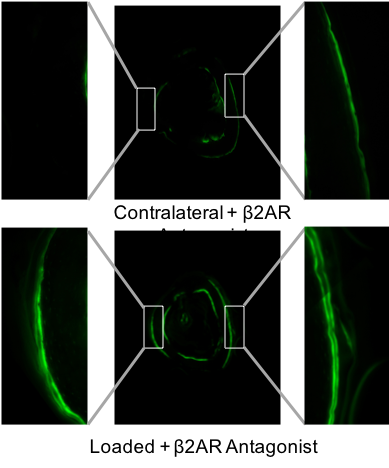
The sympathetic nervous system maintains energy balance by integrating central and peripheral tissue functions, which include skeletal remodeling. Osteoblastic b2 adrenergic receptor (b2AR) mediates sympathetic stimulation of bone resorption by direct upregulation of RANKL expression, but the diverse mechanisms by which sympathetic activity reduces bone formation are not as well defined. The goal of this study is to test sympathetic influences that alter bone formation, and to define the cellular responses and b2AR-mediated signaling events that mediate these responses. We use pharmacological and genetic approaches to address these aims in vivo and in vitro.
One aspect of our work relates to the aging-related decline in bone mass, and consequently increased bone fragility (osteoporosis) in both women and men. One factor that contributes to this condition is hypogonadal (post-menopausal) bone loss, which is driven primarily by a rapid increase in bone resorption. A second contributing factor, aging-related bone loss, is characterized by a significant reduction in bone formation as well as a gradual increase in bone resorption. A third potential factor is the elevation of sympathetic tone that results from aging-associated autonomic dysregulation. This phenomenon is less well understood than the others, and an area of intense interest in the field.
In one aspect of our studies we are investigating the possibility that increased sympathetic tone contributes to the aging-related decrease of the periosteal mechanical response, using pharmacological and genetic approaches to reduce signaling through the osteoblastic b2-adrenergic receptor. We are using Adrb2 germline and conditional knockout models to refine our understanding of which osteoblastic cell populations are primarily affected by the b2AR gene deletion in vivo and in vitro and investigating the cellular and molecular mechanisms by which b2-adrenergic receptor activity suppresses anabolic mechanoresponsive signaling.
